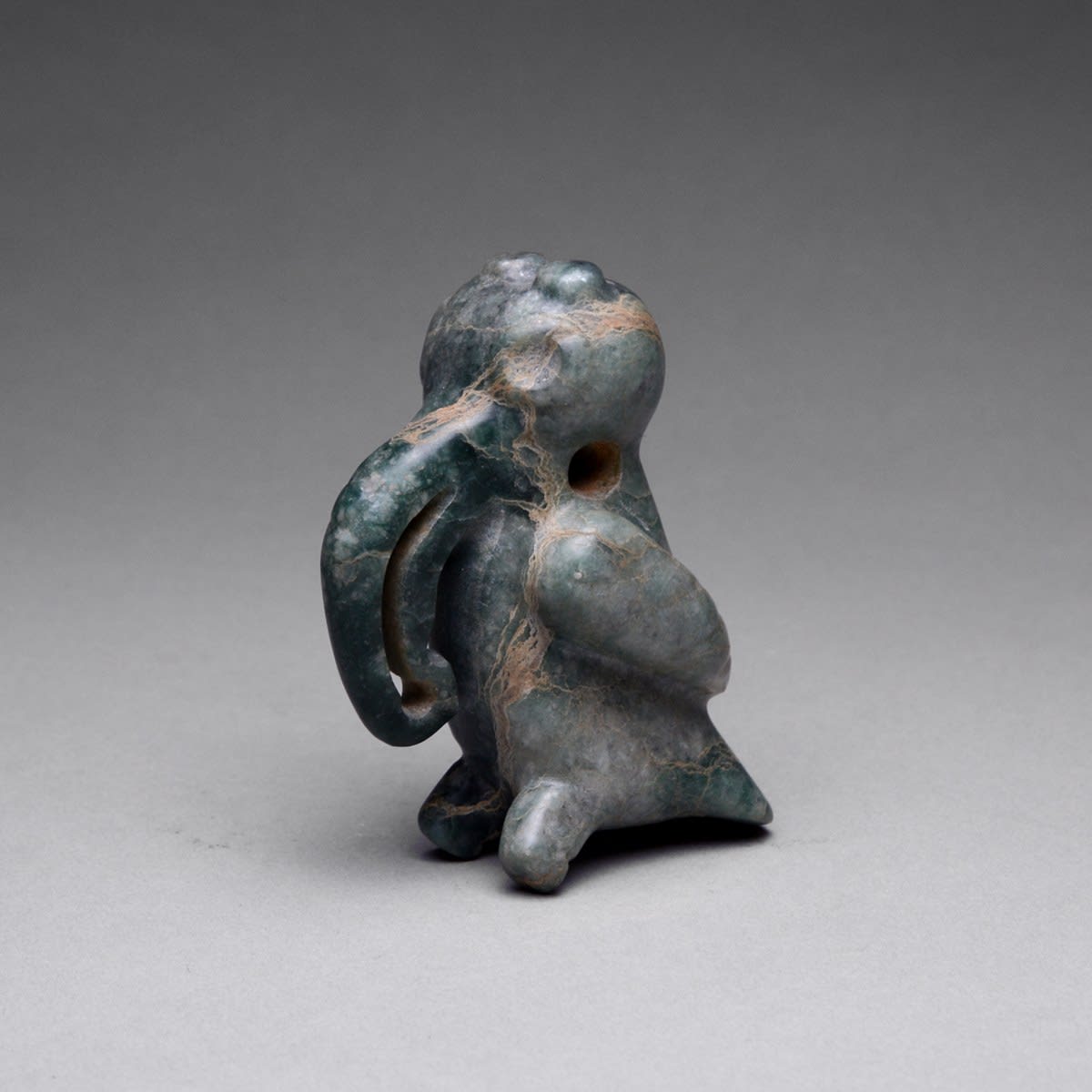Jade Pendant of a Buzzard, 100 AD to 500 AD
Jade
height 8.9 cm
height 3 1/2 in
height 3 1/2 in
PF.4281a
Further images
In the context of Pre-Columbian art and archaeology, jade is a generic term that refers to any variety of hard, dense stones that were worked with great skill by native...
In the context of Pre-Columbian art and archaeology, jade is a generic term that refers to any variety of hard, dense stones that were worked with great skill by native artists. Although jade is generally thought to be green, it can actually be a range of colors. Jade carving flourished in ancient Costa Rica for over a thousand years, roughly from 500 B.C. to 900 A.D., although the period of greatest artistic accomplishment lasted from 300 to 700 A.D. It is believed that jade working began during an extended period of agricultural abundance that allowed the ancient society to dedicate part of its energies toward the cultivation of artistic pursuits.
Jade was considered to be a sacred material by the ancient populations of Costa Rica, held in even higher esteem than gold. Generally, it was thought to symbolize that vital life force that sustains us all. The color green is naturally associated with verdant plant life. Specifically, jade was thought to symbolize the sprouting maize plant, that staple of the Pre-Columbian diet. It has also been suggested that jade represents water. Either way, we can be certain that jade represented the very essence of life itself.
To date, no native sources of jade have been discovered in Costa Rica, suggesting an extended trade network existed that imported this precious resource from Mesoamerica into Costa Rica where it was carved by local artists. Such trade also would have brought great wealth and likely reinforced the social stratification of the peoples. Jade may have served as a status marker to distinguish the elite from the masses and solidify their hold on power. We can picture an ancient ruler or shaman presiding over a sacred ceremonial adorned in brilliant green jade pendants and jewelry. The ancient Costa Ricans believe that the system of social hierarchy also extended into the afterlife. Therefore, jade objects were buried with the elite so that their power could be maintained throughout eternity.
The Pre-Columbians had a passion for luxury goods and this beautiful buzzard is a fine example. Jade was scarce and consequently highly valued. The precious material may have come into Costa Rica from lower Central America or Southern Mesoamerica in exchange for exotic goods between upper-class elite. It was then given to expert craftsmen to fashion into works of art. Most of the jade objects were found in tombs as part of ritual ornamentation: things wealthy people might want in the next life. Brought back into the light its rich green radiates life and warmth; which can actually be felt when held in the palm of the hand. Even after a millennium its brilliance still shines and captivates the imagination.
Jade was considered to be a sacred material by the ancient populations of Costa Rica, held in even higher esteem than gold. Generally, it was thought to symbolize that vital life force that sustains us all. The color green is naturally associated with verdant plant life. Specifically, jade was thought to symbolize the sprouting maize plant, that staple of the Pre-Columbian diet. It has also been suggested that jade represents water. Either way, we can be certain that jade represented the very essence of life itself.
To date, no native sources of jade have been discovered in Costa Rica, suggesting an extended trade network existed that imported this precious resource from Mesoamerica into Costa Rica where it was carved by local artists. Such trade also would have brought great wealth and likely reinforced the social stratification of the peoples. Jade may have served as a status marker to distinguish the elite from the masses and solidify their hold on power. We can picture an ancient ruler or shaman presiding over a sacred ceremonial adorned in brilliant green jade pendants and jewelry. The ancient Costa Ricans believe that the system of social hierarchy also extended into the afterlife. Therefore, jade objects were buried with the elite so that their power could be maintained throughout eternity.
The Pre-Columbians had a passion for luxury goods and this beautiful buzzard is a fine example. Jade was scarce and consequently highly valued. The precious material may have come into Costa Rica from lower Central America or Southern Mesoamerica in exchange for exotic goods between upper-class elite. It was then given to expert craftsmen to fashion into works of art. Most of the jade objects were found in tombs as part of ritual ornamentation: things wealthy people might want in the next life. Brought back into the light its rich green radiates life and warmth; which can actually be felt when held in the palm of the hand. Even after a millennium its brilliance still shines and captivates the imagination.







